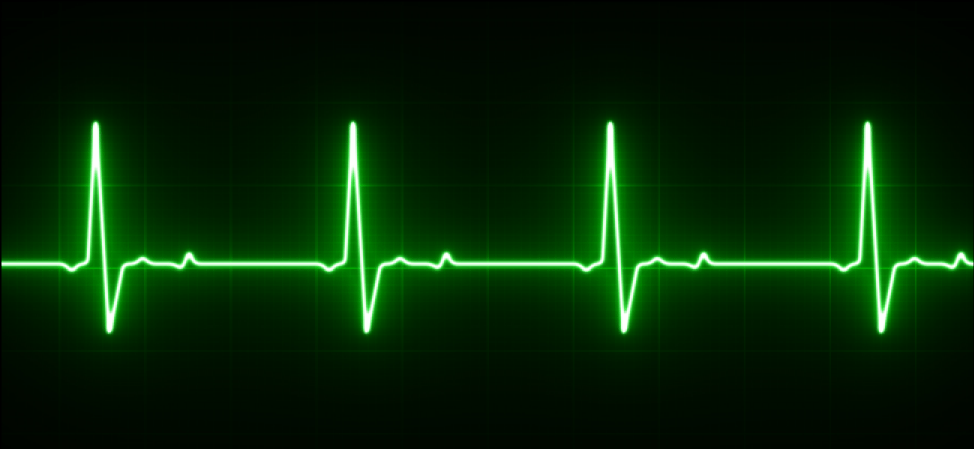By Taylor Ferrara
Imagine, for a moment, a daytime drama or any medical television show or movie. What you do imagine? Usually, you’ll imagine the blinding white doctor coats, nurses’ in green scrubs, stethoscopes hanging from doctors’ necks, people hooked up to IVs or a person crammed into either an MRI or X-ray machine being told to not move a single inch. But in any medical television show or movie, you will always find an electrocardiogram machine, a.k.a. the EKG, beeping away in the background. The slow pacing beeps typically indicate the patient is asleep or in a coma or fast pacing beeps indicating the patient is in some sort of trouble. “Important medical things are happening here, it says.”
The spikes and bumps of EKG tracings have become more talismanic and symbolic over the years rather than a device of the diagnostic information that it creates. We’ve seen urgent-care clinics, technology companies, health products, hospitals, and private medical practices use EKG tracings in their advertisement. But now that we are seeing EKGs “making its way into smartwatches, their symbolic purposes could risk overtaking their medical one.”
Medical Technology companies that have created wearable health gadgets promise that the user will have better control and management in their health. These companies advertise that portable wearable devices are more personal than seeing a doctor. “Whether it’s Fitbits counting steps and calories burned, blood glucose monitors aiding insulin dosing for diabetic patients, or Bluetooth earpieces offering round-the-clock heart rate and body temperature tracking…,” the EKG monitoring app may seem like it is making a leap in the medical technology industry. However, EKG monitoring is a bit different than the health apps and devices due to its distinct medical information. An EKG doesn’t display targets, goals or progress to its user, unlike devices such as a Fitbit that displays numerical metrics. “Reading an EKG tracing” is more of an art than math. Another way to understand this is that “a Fitbit gives you a number” and “an EKG paints a picture” of your heart.
But what does an EKG do? An EKG can measure the “flow of current” from a person’s body, display a “360-degree view of the heart’s electrical activity”, trace a person’s “heart rate, rhythm, and regularity”, and “detect which chambers are beating at what time” and which heart muscles are working properly. The most common use of the EKG is used to detect the “presence and location” of heart damage or potential heart attacks. The EKG app, which Apple Watch provides, gives the user just one vantage point—it can diagnosis some cardiac abnormalities. Apple’s EKG app won’t cause a large health impact, despite Apple’s promotional efforts in claiming this “momentous achievement…. that can provide critical data for doctors and peace of mind for you.” Dr. Sumbul Desai, the Vice President of Health at Apple, claims that the features provided by the EKG app will help its users have a better conversation with their doctors. However, there is no evidence that indicates that “taking EKGs for asymptomatic individuals is beneficial.” The average person wearing an Apple Watch would be less likely to benefit from this app. Years ago, the average apple watch user was a “40-year-old male.” However, an average apple watch user older than 65 may become the average Apple Watch user. The “Center for Disease Control and Prevention” states that only two “percent of patients younger than 65 suffer from atrial fibrillation, the only arrhythmia that the Apple Watch is approved to detect.”
The first EKG machine weighed about 600 pounds, needed to have an available supply of water to cool its huge electromagnets, and “required five skilled operators” to use it. The EKG was nearly impossible to use, and it was difficult to interpret its results. Today, the machine is more streamlined, and the future indicates that EKG will continue to downsize and become more integrated into our lives. No matter how big or small the EKG will become, it will always try to record the shape, size and “timing of the heart’s intrinsic electrical impulses” to give an individual the capability to track, review, study and maybe even intervene with irregular heart functions. In other words, the EKG transforms this artist heart information into a machine that can be studied, monitored, and, to a certain extent, mastered.
The commonality of an EKG may produce a new meaning on its own other than it is producing pictures and raw data that would need to be interpreted by a medical professional. As the primary meaning behind an EKG shrinks, the secondary, more symbolic, meaning would grow and replace the primary meaning. The portable and wearable EKG offers a sense of comfort, almost like it’s a talisman that is “warding off evil”, whether it is used or not.
Student Bio: Taylor Ferrara is a second-year student at Suffolk University Law School and a staff member on the Journal of High Technology Law. She received her B.S. in Management Information Systems from the State University of New York at Plattsburgh.
Disclaimer: The views expressed in this blog are the views of the author alone and do not represent the views of JHTL or Suffolk University Law School.

